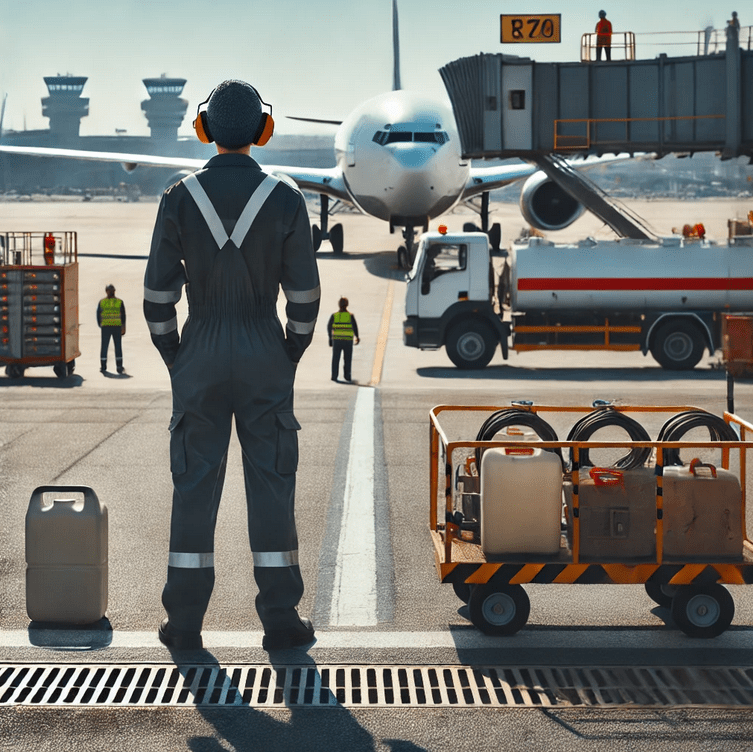In the fast-paced environment of modern airports, safety is a top priority, ensuring the well-being of both employees and passengers while maintaining smooth operations. As the industry evolves with decarbonization initiatives, automation, and sustainability efforts, it also faces new safety challenges. Managing these challenges requires a comprehensive and integrated approach to safety—one that considers every aspect of the airport’s complex ecosystem.
This article examines the critical safety challenges in airport operations, highlights key safety concerns, and explains how a holistic approach to risk management can address these issues effectively.
Through collaboration, updated safety protocols, and workforce training, the airport industry can continue to operate safely as it transitions to new technologies and methods.

Main Safety Challenges in the Airport Environment
The airport industry operates within a diverse range of activities, each carrying its own risks. From the tarmac to the terminal, safety must be addressed comprehensively to ensure no aspect of airport operations is left unconsidered. The growing use of alternative fuels, the increasing reliance on automation, and the push for sustainable practices have transformed how airports operate. These changes bring unique safety concerns that must be managed.
1. Aircraft Maintenance and Refueling
Airports are hubs for the maintenance and refueling of aircraft, both of which involve high-risk activities. As airports move towards using alternative fuels such as biofuels or hydrogen, there are new challenges in handling, storing, and using these materials. Workers and ground staff must be adequately trained in dealing with these fuels to prevent accidents and ensure compliance with safety regulations.
2. Automation in Ground Handling Operations
Automation is playing an increasingly important role in ground operations, from baggage handling to aircraft servicing. While automation improves efficiency, it also poses potential risks, such as equipment malfunctions or collisions involving autonomous vehicles. Ensuring that safety protocols keep up with these technological changes is vital, and workers must be trained to operate, oversee, and troubleshoot automated systems.
3. Passenger Safety and Terminal Operations
Airports are busy environments where passenger safety is of utmost importance. The large number of people moving through terminals, combined with automated systems for security checks and baggage screening, requires vigilant safety monitoring. Additionally, health and security risks—such as the spread of infectious diseases or potential terrorist threats—demand continuous oversight and proactive risk management.
Safety Hurdles in the Airport Industry
Several significant hurdles must be overcome to ensure ongoing safety in the rapidly changing airport environment:
| Safety Hurdle | Challenges |
|---|---|
| Handling of Alternative Fuels | New fuels require updated training, handling techniques, and safety systems to mitigate unique risks. |
| Regulatory Lag | Regulations often lag behind technological advancements, creating compliance challenges. |
| Automation and Human Oversight | Automation requires human supervision to prevent failures, breakdowns, and equipment-related incidents. |
| Terminal Congestion | High passenger volumes increase the likelihood of safety and security incidents. |
Managing Safety Risks through Holistic Risk Management
A holistic approach to risk management is essential to address the unique safety challenges that airports face. By considering every element of airport operations—from ground handling and fueling to terminal operations and security—this approach allows safety to be viewed as an interconnected system. The following components are key to a successful safety management strategy:
1. Integration of Safety Systems
For effective safety management, all airport operations, including the management of aircraft, passengers, and cargo, must be integrated. Safety protocols should encompass the entire operational framework, from ground operations to airside services. This integration ensures that potential risks do not fall through the cracks.
2. Proactive Risk Identification and Management
Anticipating potential safety risks, rather than reacting to incidents, is crucial. Airports should conduct regular risk assessments and simulate potential failure points, ensuring systems are robust enough to handle any safety threats.
3. Collaborative Safety Framework
Safety cannot be managed in isolation. Airport operators must collaborate with airlines, regulatory authorities, and contractors to ensure that all parties adhere to the same safety standards. This also includes sharing data and best practices to prevent incidents before they occur.
4. Regulatory Updates and Compliance
As airports continue to innovate, regulations must evolve to keep pace. Airport operators need to actively participate in updating safety guidelines and regulations to ensure their operations remain compliant with the latest safety standards. This also includes adapting to global standards like those set by the International Civil Aviation Organization (ICAO).
5. Workforce Training and Development
Human error remains one of the most significant risks to airport safety. Continuous training of airport staff is essential, especially as new technologies like automation and alternative fuels become standard in daily operations. Ensuring that staff are competent in both traditional and modern safety practices is key to mitigating risks.
Key Safety Considerations for the Future
As the airport industry embraces decarbonization and new technologies, these innovations come with their own set of safety challenges:
| Category | Future Safety Challenges |
|---|---|
| Alternative Fuels | Training staff to safely handle and store new, volatile fuels like hydrogen and biofuels. |
| Automated Systems | Ensuring human oversight and updating maintenance protocols for autonomous ground vehicles. |
| Passenger Safety | Implementing advanced screening technologies and emergency response systems for large crowds. |
| Environmental Factors | Addressing the impact of extreme weather events on aircraft and ground safety operations. |
The transformation of the airport industry, driven by decarbonization and automation, presents both opportunities and challenges for safety management. By adopting a holistic risk management approach that integrates all aspects of airport operations, the industry can continue to evolve while maintaining the highest safety standards.
Proactive risk management, workforce training, and collaboration across stakeholders are vital to ensuring that airports remain safe environments for both passengers and staff. As regulations adapt to new technologies, the industry must stay ahead of the curve to meet the demands of tomorrow’s challenges.
In a world of constant change, safety will continue to be the foundation of success in the airport industry.

No comments yet